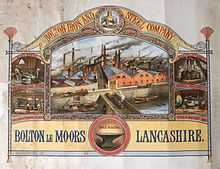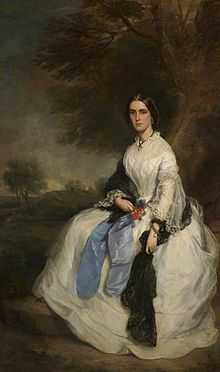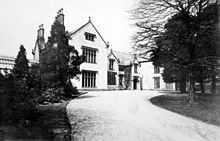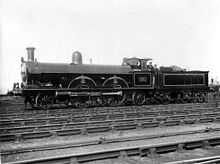John Hick (MP)
| John Hick, Esq., JP | |
|---|---|
_colour.jpg) | |
| Born |
2 July 1815 Bolton |
| Died |
2 February 1894 Whalley, Lancashire |
| Nationality | British |
| Occupation |
Civil and Mechanical engineer Politician Company director |
| Religion | Anglican |
John Hick JP, DL, MP, FRSA (2 July 1815 – 2 February 1894) was an English industrialist, art collector and Conservative Party politician who sat in the House of Commons from 1868 to 1880.
Hick was the eldest son of Benjamin Hick (1790–1842), a civil engineer, and his wife Elizabeth Routledge (1783–1826), daughter of William Routledge of Elvington Yorkshire. Elizabeth's brother (John's uncle), Joshua Routledge (1773–1829) also an engineer living in Bolton, designed the Engineer's Improved Slide Rule and in February 1818 patented improvements to the Rotary Steam Engine.
Educated at Alderley in Cheshire and Bolton Grammar School Hick became a partner in the engineering firm of B. Hick and Sons, later Hick, Hargreaves, & Co and a member of the Institute of Civil Engineers in 1845. He was Church Warden for James Slade, Governor of Bolton Grammar School, Town councillor for nine years from 1844, a member of the Society of Arts, founder member of the Institution of Mechanical Engineers from 1847 until 1852, member of the London Association of Foreman Engineers and Draughtsman, National Society for Promoting the Education of the Poor in the Principles of the Established Church in England and Wales, Justice of the Peace for the Borough of Bolton and Salford Hundred, liberal patron of the fine arts and a director of the London and North Western Railway under the chairmanship of Sir Richard Moon and Lord Stalbridge, from 1871 until his death in 1894.[1]
In 1839 (age 23) while working for B. Hick and Son, John Hick Jr as he was referred to at the time, was awarded the Silver Medal by the Society of Arts for his novel invention of an expanding mandrel for turning lathes, it was an adaptation of a principle developed by Marc Brunel for pully block manufacture at Portsmouth and received the praise of three eminent engineers; Bryan Donkin, Joshua Field and John Rennie.
During 1842 Hick was awarded a second silver medal by the Society of Arts for his invention of an Elliptograph; the device provided a simple and accurate solution for the drawing ellipsoid forms of various proportions. Hick received further praise from James Nasmyth, William Fairbairn, Joseph Whitworth, and amongst others, Charles Holtzapffel, Chairman of the Committee of Mechanics. Models of both devices were placed in the Society's repository.
Hick contributed a paper to the Institute of Mechanical Engineers in 1849 on a friction clutch for connecting and disconnecting the driving power with shafts and machinery.
Marriage
John Hick married Margaret Bashall (1824–1872), eldest daughter of industrialist William Bashall, partner in Bashall & Boardman of Farington Lodge, near Preston on 24 June 1846.[1] Following Margaret Hick's death in 1872, he married the sister of his son-in-law, Rebecca Maria Ashworth (c.1830–1908), eldest daughter of Edmund Ashworth JP (1800–1881) of Egerton Hall on 16 December 1874 at Holy Trinity Church, Clapham; the couple were married by Margaret Hick's cousin and brother-in-law Reverend William Bashall (1830–1902),Vicar of Deane, Lancashire, by special licence from the Archbishop of Canterbury, Archibald Tait. Edmund Ashworth was a cotton manufacturer, proprietor of E. Ashworth & Sons and Egerton Mill, founder member of the Anti-Corn Law League with his brother Henry Ashworth (1794–1880) JP, in association with John Bright and Richard Cobden, and supporter of reforming, anti-slavery and peace organisations. Ashworth is thought to have been Oswald Millbank in Benjamin Disraeli's novel Coningsby. The two families (Hick and Ashworth) were linked by marriage in 1868 when Hick's first child and eldest daughter Margaret (1847–1929) married Edmund Ashworth Jr (1833–1901). The highly respected Reverend Bashall retired to the position of curate at St Barnabas church, Kensington from about 1876 until his death in 1902.
The Great Exhibition

1851 saw the Crystal Palace Exhibition in Hyde Park; early in 1850 Mayor of Bolton, Thomas Lever Rushton (1811–1883) was appointed chairman of a committee to organise the town's efforts toward the Exhibition and presented as a Local Commissioner to Prince Albert at St James's Palace 18 March 1850. While the family business of Benjamin Hick and Son displayed machinery and engineering models in the Crystal Palace, John Hick also sat as a United Kingdom Juror with the notable figures of William Fairbairn, John Farey, Henry Maudslay (1822–1899), grandson of Henry Maudslay, Rev. E. Moseley and Robert Napier for Class V. Machines for Direct Use, Including Carriages, Railway and Marine Mechanism.
In 1855 Hick exhibited two pieces from his collection of art works: The Stag Hunt in the Division Des Beaux-Arts and Lady Jane Grey and Roger Ascham by John Callcott Horsley in the Fine Art Division of the Exposition Universelle (1855) alongside his father-in-law William Bashall who presented The Madrigal, also by Horsley. Robert Napier served as a Juror. Hick and Bashall used the same pair again for the 1857 Art Treasures Exhibition in Manchester.
Hick was a force behind the movement that led to the formation of the 27th Lancashire Rifle Volunteers from the Bolton area on 15 November 1859 following tensions between the United Kingdom and France and the out break of war between France and the Austrian Empire during April of the same year. He was offered command of the regiment, but declined; William Gray MP JP (1814–1895) and former Mayor of Bolton became Lieutenant Colonel 1 January 1861; John Hick's nephew Benjamin Hick (1845–1883), partner in Hick, Hargreaves & Co, was made a Captain 16 March 1872, resigning his commission about four years later 23 February 1876.
In 1860 partners in B. Hick and Son, John Hick and William Hargreaves joined Thomas Lever Rushton's brother-in-law Henry Sharp as partners in Sharp and Eckersley, formerly Rushton and Eckersley before Rushton's retirement from the firm. The three partners Sharp, Hick and Hargreaves formed the Bolton Iron & Steel Company; Bessemer steel making began in 1863 - four six-ton Bessemer converters were installed, followed by the Sieman's open-hearth process in 1867. During 1865 Bolton Iron & Steel cast the largest anvil block made in England, weighing 210tons. In 1869 the company was manufacturing steam hammers to the design of Francis Webb.[2]

About 1861 society painter Francis Grant produced portraits of John Hick and his wife Margaret, both works eventually hung together in the family home at Mytton Hall. Hick was an associate of Bolton engineer, artist and photographer Reuben Mitchell (1812–1895), and pursued his own interest in photography,[3] he was also a supporter of the artists Copley Fielding, William Powell Frith, Patrick Nasmyth, Samuel Prout, Edward Matthew Ward and Benjamin West; the engineer and artist James Nasmyth described John Hick as an excellent friend.
Hick wrote a history of Timothy Hackworth's locomotive Sans Pareil and presented the restored engine to the Patent Office Museum (now the Science Museum) in 1864. Sans Pareil was previously owned by Hick's brother-in-law and eventual business partner John Hargreaves Jr (1800–1874) who had the engine fully repaired and running on the Bolton and Leigh Railway in 1837. Sans Pareil is now housed at the National Railway Museum's Shildon Locomotion Museum annexe.
Parliament
On 17 November 1868 Hick was elected as Member of Parliament (MP) for Bolton. After election and to avoid a conflict of interest, he immediately resigned his position within B. Hick and Son, the firm were already in possession of government contracts, and withdrew from active involvement in the Bolton Iron and Steel Company. Hick held the seat until 24 March 1880[4] when as a result of ill-health, he chose not to stand for re-election.
Hick was a liberal Conservative in favour of education based on religion, a supporter of the general principles of the Education Act 1870 and an adherent to the view that religious and secular education should not be separated. As a Conservative he was a member of the Carlton, Conservative and St Stephen's Clubs.
In May 1870 Hick chaired a Select Committee to investigate steam-boiler explosions; following the report in August 1870, he introduced a Bill "...to provide a more efficient remedy to persons injured and property damaged by the explosion of steam-boilers through negligence". In April 1871 he seconded a motion by Colonel Barttelot (1820–1893), Conservative MP for Sussex Western 1860–1885, for a Select Committee "...to inquire into the merits of the Martini-Henry Rifle..." and debated Supply – Army Estimates, June 1873. Hick also served on a Select Committee appointed June 1874 to investigate the testing of chain cable and anchors for the Navy, and debated Railway accidents – the adoption of continuous brakes, June 1879.
Hick was Deputy Lieutenant for the County Palatine from 1870 and on taking up residence at Mytton Hall, Justice of the Peace for Whalley, Lancashire, he rejoined the Institute of Mechanical Engineers in 1871, proposed by Frederick Bramwell and elected a Member of Council in 1872, a Vice-President of the institute from 1874 to 1876.

For his contribution to the 1873 International Exhibition at South Kensington Hick was presented with a Bronze Medal,[5] he was a member of the Permanent Committee for the Representation for British Pictures for the 1874 International Exhibition with fellow MPs Henry Bolckow, Alexander Brown, Henry Eaton, Joshua Fielden, William Graham, John Snowdon Henry, John Pender and others.
On 15 March 1879, towards the end of his time as an MP, John Hick along with C.D. Abel, Colonel Frederick Beaumont (1833–1899) Liberal MP for South Durham 1868–1880, F. Bolton, Alexander Brogden JP (1825–1892) of John Brogden and Sons, Liberal MP 1868–1885 for Wednesbury, J.T. Jones and J. Turay registered the Aqueous Works and Diamond Rock-boring Company (Limited), Crown Works, Guildford Street, York Road, Lambeth. The company "...bought out and patented the system of using diamonds for boring".
Pollution trial
After leaving parliament Hick and Lt-Col. Ralph John Aspinall JP, DL, campaigned against the pollution and poisoning of salmon and trout in the River Ribble and its tributories by local industry; Hick raised the issue of pollution in the Ribble during the third reading of the Rivers Pollution Prevention Act 1876. Aspinall and Hick fought a publicised and successful legal battle in the Court of Chancery against the cotton mills of Mitchell and Carlisle during July 1880. The river ran close to Mytton Hall where landlord Aspinall held the fishing rights and John Hick was lessee from 1874. The trial was presided over by the Vice-Chancellor of England, Sir James Bacon.
In December 1880 Hick and Aspinall received presentations at Mytton Hall from the local angling community in recognition of their services in preventing pollution to the River Ribble and its tributories.
Science Museum
During 1887 Hick was a member of the mechanical collections committee chaired by John Slagg, MP with other experts and politicians; Sir William Armstrong, Sir Joseph Bazelgette, James Brunlees, Edward Cowper, Professor T. M. Goodeve, Sir Charles Gregory, James Howard, MP, Charles Manby, John Hinde Palmer (d.1884), Sir Edward Reed, MP and Sir Bernhard Samuelson, MP established with several committees for the purpose of advising a central committee appointed by the Treasury to investigate the forming of a Science Museum and National Gallery of Portraits in South Kensington, sited between the Natural History Museum and what was to be the Imperial Institute.
Death

Previously of Hilltop, Belmont, Lancashire Hick died at the age of 78 after some months of failing health when living at Mytton Hall, Whalley, Lancashire and the Isle of Man, where he was also a Justice of the Peace.
Like his father Benjamin he accumulated a large and valuable collection of art works, some of which was inherited, and devoted his final years at Mytton Hall to compiling an elaborately illustrated catalogue of his collection; some of these works were auctioned by Christies during June and July 1909 following Rebecca Hick's death in 1908.
From the year of his death the London North Western Railway (LNWR) produced 10 steam locomotives of the John Hick Class (1894–1898); a Francis Webb design of 2-2-2-2 configuration, engine No. 20 named John Hick. The following 9 engines were named after engineers and inventors, principally from the industrial and Second industrial revolution: No. 1505 Richard Arkwright, No. 1512 Henry Cort, No. 1534 William Froude, No. 1535 Henry Maudslay, No. 1536 Hugh Myddelton, No. 1548 John Penn, No. 1549 John Rennie, No. 1557 Thomas Savery and No. 1559 William Siemens.
References
- ↑ 1.0 1.1 Debretts House of Commons and the Judicial Bench 1870
- ↑ "Bolton Iron and Steel Co". Grace's Guide. Grace's Guide Ltd. Retrieved 6 December 2014.
- ↑ Reed, Sims. "MITCHELL, Reuben.". Sims Reed Rare Books. Sims Reed Rare Books Ltd. Retrieved 10 June 2014.
- ↑ Leigh Rayment's Historical List of MPs – Constituencies beginning with "B" (part 4)
- ↑ "COMMEMORATIVE MEDALS, BRITISH HISTORICAL MEDALS". Baldwin's. Lot No. 384: A. H. Baldwin & Sons Ltd. Retrieved 6 November 2014.
External links
| Parliament of the United Kingdom | ||
|---|---|---|
| Preceded by William Gray Thomas Barnes |
Member of Parliament for Bolton 1868 – 1880 With: William Gray John Kynaston Cross |
Succeeded by John Pennington Thomasson John Kynaston Cross |